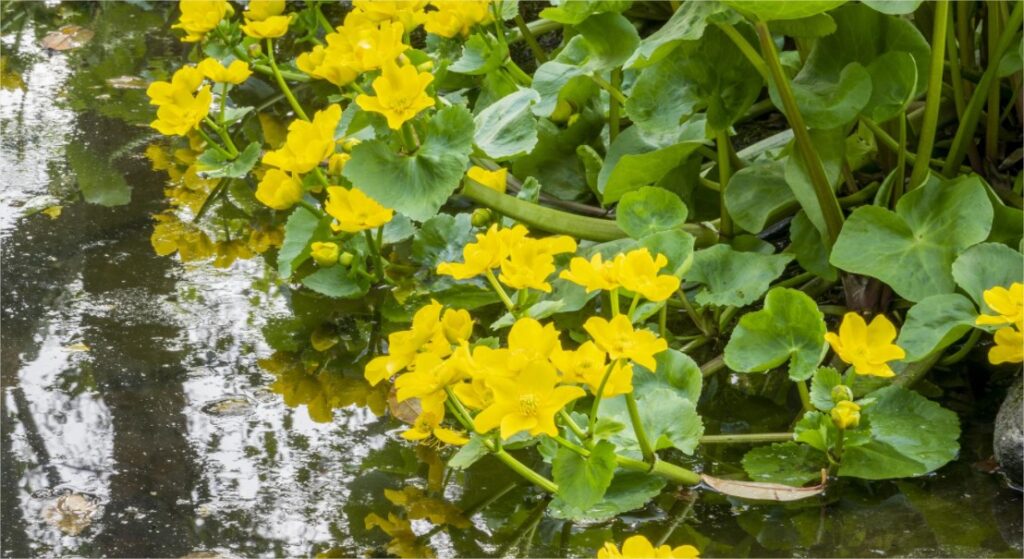Which ones are the best plants to choose for your garden pond? We think that plants are the best way to maintain clear, healthy water. Biological filters maintain good water quality by breaking down harmful ammonia from fish waste and nitrites from decaying plant matter
Aquatic plants play an ornamental role, but they also help maintain the balance of the ecosystem around your garden pond. It is therefore important to focus on the most useful species in order to promote the development of an ecosystem and maintain its balance.
You must limit the amount of aquatic plants that grow in a pond so that small animals can live there. Discover the different varieties of filtering and oxygenating plants that are suitable.

Why Use Filter Plants?
The presence of both filtering and decorative aquatic plants allows you to naturally fight against the proliferation of algae that quickly invade the bottom of your garden pond. When the water is purified, it has all the qualities necessary for watering your garden because it contains all the nutrients essential for the development of your vegetables, aromatic plants or flowers. You will then use the rainwater that collects there and you will achieve significant savings.
If you select the most suitable filter plants for your garden pond and you set up an ecological management of your pond, you will no longer need to invest in equipment such as the filter, the pump, -algae, lighting or fertilizers. Discover our guide to essential aquatic plants here.
You can achieve ecological management of a basin by planting fast-growing species that need nutrients to thrive. It helps to obtain the nutrients in the water from the decomposed leaves and the droppings of animals that live there. They arise from the biological and chemical phenomenon called the nitrogen cycle.
How to choose best plants for pond?
I will recommend you to choose cleansing herbs that grow naturally in your area to make them more easily adapt to the environment you have created. Maintaining these species will not be difficult and it helps to filter your pond naturally for a defined period or throughout the year.
1. The purifying properties of grasses
Grasses are among the purifying aquatic plants and are among the varieties that lagoon experts use. These plants grow in shallow water. Here is a list of the most commonly used grasses in pond or pond construction:
The aromatic reed or scent rush: this is one of the best plants for filtering pond water. With a height of between 0.5 meters and 1.2 meters, its small green flowers contributes in distinguishing and a spathe that resembles its leaves. This plant absorbs the phosphate found in the water and its filtering properties. Also, the technicians specializing in lagooning appreciate its properties.
Iris pseudacorus : both decorative and purifying, grows almost everywhere in Europe and grows well in France. With a height of 1.20 meters, the pretty yellow flowers are very beautiful. Easy to maintain, effectively purifies water bodies by absorbing a lot of nutrients;
The water ribbon (Sparganium erectum) : this herbaceous plant which measures 0.5 meters in height can be recognized by the zigzag shape of all of its flowers. Thanks to its iron and manganese requirements, it absorbs these elements when they are in the basin and helps to make the water clearer.

2. Oxygenating plants
Varieties of oxygenating plants are also essential to guarantee the ecological balance of the basin. Oxygen is produced and diffused through the leaves and these species consume the nutrients in the water to grow. However, each strain only releases oxygen for a limited time.
It is for this reason that it is necessary to combine complementary species such as purifying plants which remain active all year round. You can choose between aquatic buttercup and waterweed to provide oxygenation in the fall and summer. The marsh hottonia, for its part, differentiate by its pretty white or pale pink flowers that will beautify your pond from May to July.
Warning: you must avoid planting oxygenating species in a pond or pond whose bottom is already got a layer of algae, with green water. Indeed, as the algae absorb CO2 from the water, oxygenating plants will find it difficult to develop there.
Which purifying plants to choose?
Purifying plants filter the water in the pond and are distinguished by activity throughout the year.
Veronica beccabunga is a flowering climbing plant. It grows in wet areas and quickly lines the place thanks to the ramifications of its stems. This winter-resistant species absorbs a large amount of nitrates. It allows the natural management of the basin to be established throughout the year
Nasturtium officinale : it is distinguished by its small flowers. It appear in summer and is one of the purifying plants that remain active throughout the year. Note that watercress only grows in places where there is a large amount of running water;
Hippuris vulgaris : this purifying aquatic plant, native to Eurasia and North America. It is planted in the spring and effectively purifies the water in the basin.
- It absorbs impurities and excess nutrients that result from the decomposition of animal and plant waste.
- Also, It is recommended for small bodies of water because it does not grow too quickly.
- It purifies throughout the year, but is most active in the spring.
So, now that you know the different varieties recommended by lagoons professionals. Next step is to select the aquatic plants that will allow you to have clear water all year round. In addition, Take into account the area of your pool and your availability for the maintenance of your green spaces.










